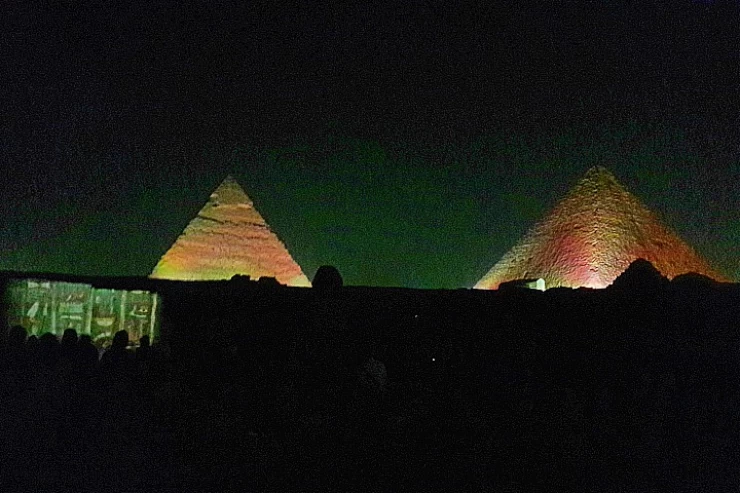
King Cheops | King Khufu | Owner of the Great Pyramid
Owner of the Great Pyramid
Khufu was the son of King Sneferu and Queen Hetep Haris and the brother of Princess Hetephres. Unlike his father, he was known for his cruelty and severity in his rule, as mentioned in historical texts. He had nine sons, including Djedef-Ra, his crown prince. He also had 15 daughters, including Hetephres II, who later became queen.
Researchers and historians have tried to estimate the amount of time it took to build King Khufu’s Great Pyramid of Giza. It is believed that its construction took 20 years, while the ascending road, ramps and foundations preparation took another 10 years. The job seems to have been continuous throughout the year and not only during particular seasons such as summer or floods. Between twenty thousand and thirty thousand workers participated in this project. It has been estimated that between one million five hundred thousand and two million three hundred thousand stones were used for constructing the Great Pyramid.
Each stone weighs from one point five tons up to two point five tons. Most importantly, some granite blocks used for building roof of a king’s burial chamber may weigh even fifty tons per piece. There were also engineers and foremen involved in the design and planning of the pyramid and its outbuildings. This work was always done under the supervision of the king himself, who visited the site from time to time.
Ham Euno may have been the main engineer responsible for the construction of the Great Pyramid of King Khufu, and we know of other foremen who were involved in this work, such as the workers Anti-Shadow and Kai, whose tombs, statues and tools were recently found in Giza near the workers' village.
South of the eastern side of the pyramid is a modern building that houses the boat that was discovered in 1954. It is a huge royal boat made of cedar wood, which was found disassembled in the pit and is one of the largest boats found in Egypt so far. On the front of the boat's deck, there is a canopy, the center part of which is covered by a frame that holds the canopy. In the aft part of the boat, there is the main cabin and this takes the form of a roof supported by poles from trees that produce palm leaves.
The boat has two oars that control the rudder while five pairs of oars help to steer it with a length of about 43.3 meters or 142.02 feet and a width of approximately 5.90 meters or 19.35 feet, height being about 5 meters or 16.4 feet at the bow as well as 7 meters or 23 feet at the stern. The king's funeral furnishings were sent by water. While some boats were made as models, it is clear that this boat was actually used as evidenced by the noticeable shrinkage of the remaining ropes.
At present, the Great Pyramid stands as an assurance of Khufu's vision and the ingenuity of the ancient Egyptian civilization. Whether it is divine supremacy or a human marvel, such grandiosity and mysterious features in this grand work draw millions of people who marvel at its bared beauty and the secrets it keeps within.
Although the reign of King Khufu ended over 4,500 years ago, his very shadow is felt through time and ensures that he remains one of the most enigmatic and most ambitious rulers of ancient Egypt.
Contrary to his gigantic pyramid, not much is known about the personality of Khufu. His ruling has been reported in varied ancient sources: while some describe him as a stern and despotic king, others report him as a just and god-fearing leader. The only extant life-size statue of Khufu, carved in ivory, has been discovered from Abydos and serves as rare evidence of the appearance of this ruler.
It can be so difficult to imagine such an immense structure; the fact that the whole of London's parliament and Saint Paul's Cathedral could be contained there comfortably may perhaps help you get an idea.
Napoleon Bonaparte, the passionate admirer of Egyptian antiquities, was so impressed by his visit to the plateau of Giza that (thanks to the help of his mathematicians) he was able to officially announce that in the three pyramids, there was enough stone to build a three-meter-high wall that surrounded the whole territory of France.
The Great Pyramid is, among all, the one aligned most precisely. It is clear that the orientation had to be very important for engineers and supervisors. However, we do not know for sure if such precision was a practical response to the Bent Pyramid in Dahshur and Meidum accidents, or if at the base there was simply a religious need that made it necessary to align the funeral chamber (and consequently the body of the deceased pharaoh).
Here, Cheops was to be buried for eternity in his Aswan red granite sarcophagus. However, some Egyptologists believe that all three rooms were part of the original plan; in particular, the "Queen's Chamber" would have served as a serdab room, in which a statue of the late pharaoh was to serve as a substitute for his body. Five rooms were built above the "King's Chamber" to lighten the structure, an innovation that served to distribute the load of the pyramid that would otherwise have overloaded the ceiling of the burial chamber. Without worrying about understanding the key terms of Egyptian history, we will see an Egyptologist guide, who will meet your expectations.


















